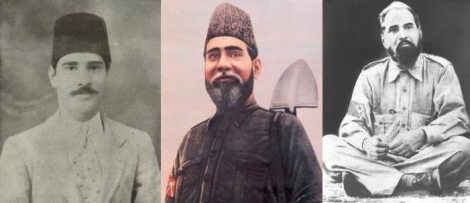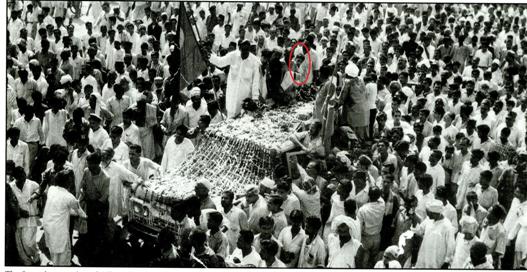|
Allama Mashriqi, His Family & the
Khaksars Paid the Price for Freedom
On
Mashriqi’s 52nd Death Anniversary and the
Anniversary
of the End of British Rule in the Sub-continent
By Nasim Yousaf
History has shown that freedom comes at a steep
cost to those who fight to liberate a nation from oppression. Allama Mashriqi, his
family, and the Khaksars paid the price for the freedom of the subcontinent
through their tremendous sacrifices for the nation.


In 1930, Allama Mashriqi, a
legendary freedom fighter, founded the Khaksar Tehrik to liberate the subcontinent
(now comprised of Bangladesh, India and Pakistan) from the clutches of foreign
rule. The Tehrik was a private army based on the principles of social service,
brotherhood, and discipline. The movement’s message of justice, equality and
freedom resonated with the masses and it quickly spread across India. By 1940,
the Tehrik was the most powerful and disciplined private army in all the region
and was comprised of millions of members. Through demonstrations, marches,
camps, pamphlets, speeches, Khaksar newspapers (e.g.“Al-Islah”), and other
activities, the Khaksars had mobilized the masses for freedom.
Recognizing the Tehrik’s growing
power and influence, the British Government desperately tried to crush the
movement from the very beginning. In 1932, they barred Mashriqi from entering
the North West Frontier Province (now Khyber
Pakhtunkhwa) - the ban continued until 1937. And later, in 1940, when
Mashriqi was on the verge of ending British rule, police killed many Khaksars in
a brutal assault (on March 19, 1940) and arrested Mashriqi and his elder sons.
Authorities also raided Mashriqi’s house and cruelly injured Mashriqi’s son
Ehsanullah Khan Aslam. The news of Mashriqi’s arrest and the massacre of the Khaksars
spread worldwide and was reported on the radio and in print media (in India,
Australia, Germany, UK, USA, and other international outlets).
The massacre of Khaksars on March 19
was a black day and a turning point
in the history of India. The horrific actions of the Government created
tremendous public outrage and further compelled the masses to drive for
freedom; the Khaksars and their followers were now even more determined to
attain independence for the nation. Seeing the movement as a grave threat to
their rule, the British further intensified their efforts against Mashriqi and
the Khaksars. Planning meetings were held by the British Government to try to
preserve their rule and the Government launched massive efforts to crush the
Khaksar Movement. They banned the Khaksar Tehrik (first in Punjab and later in
the entire India) and its “Al-Islah” newspaper. Police raided Khaksar offices
across India and seized or impounded Khaksar materials. Many seized Khaksar
materials were also sent to the Viceroy of India and other high-level British
officials in India and England. Thousands of Khaksars and Mashriqi’s sympathizers
were arrested, injured, or killed and several were sentenced to life
imprisonment. The Khaksars, whether in jail or not, were persecuted and their
families harassed. Many were falsely accused – without any proof of violent
activity – of being terrorists or “fifth columnists.” All along, the Secretary
of State and Viceroy of India were actively involved. The Viceroy held a
meeting with the British Commander-in-Chief of the Indian Army and other
British high-ups and discussed ways to crush the Khaksar Tehrik. The
authorities made desperate efforts to try to implicate and defame Mashriqi and
his organization; even though the Government found no credible evidence against
him, Mashriqi was kept imprisoned without a court trial for a long period of
time, as the British knew that no other organization posed a greater danger to
their rule in India.
Beyond their actions against the
Khaksar organization, the British also tried to attack Mashriqi on a personal
level. Mashriqi was kept in solitary confinement at Vellore Central Jail. The
Government confiscated his accounts and property. For this reason, Mashriqi’s
son (Ehsanullah Khan Aslam), who was injured during the police raid on March 19th,
was not able to obtain proper medical treatment; he eventually succumbed to his
injuries and died on May 31, 1940. He was buried in Lahore; Mashriqi was not
allowed to be with his family during this time nor to take a final glimpse of
his son. Meanwhile, other members of his family and followers were harassed or
tortured. The lives of his young daughters (Hameedhah, Mehmoodah, and Masuda,
who were from his first wife, Wilayat Begum) and wives were threatened.
Mashriqi wrote:
“The
most recent and the crowning addition to the above tyrannies is an anonymous letter
posted from clearing Charing Cross Post Office Lahore on the 4th July
1941-delivered to me on the 11th July-threatening the life of my ladies at
Ichhra!...In the distress that I have felt over the threat and the insult, also
in the helplessness to which I have been reduced, I have no alternative but to
put this also to the credit of the Government who have taken possession of my
body most unjustly and have reduced me to this state.”
Despite the atrocities against him,
Mashriqi remained resolute and ultimately decided to begin a fast unto death
while in prison to continue the push for freedom and obtain his and the
Khaksars’ release. When he was on the verge of death, the Government finally
released him (although they still restricted his movements).
Ultimately, in spite of the
Government’s best efforts, they could not stop Mashriqi and the Khaksars’
determination to bring freedom. The Khaksar resistance and anti-imperialist
activities pushed the Government to the point where they had no choice but to
leave the sub-continent. The sub-continent thus obtained its independence and
Pakistan and India emerged on the world map (for a detailed account, read the
author’s published works).
Mashriqi continued fighting for
justice for many years following independence. He died in Mayo Hospital in
Lahore on August 27, 1963. With his death, a vital chapter of South Asian
history was closed. News of his death spread like wildfire; special bulletins
by major newspapers were published and distributed in the streets of Pakistan.
The day after his death, nearly all the newspapers in the country (including Dawn, Pakistan Times, Jang, Nawa-i-Waqt,
Kohistan, Imroze, Mashriq, The Eastern Times, and others) featured the news
in front-page headlines. International media also reported of Mashriqi’s death.
Mashriqi’s millions of followers and supporters around the world were
grief-stricken. Condolence messages poured in from prominent leaders, including
the President of Pakistan (Ayub Khan), and from supporters all over the globe.
Airplanes, buses, cars, and trucks full of people arrived in Lahore to attend
Mashriqi’s funeral procession, which was over a mile-long and included more
than 100,000 people. All along the route, people showered Mashriqi’s body with
flowers. Many wept and some even fainted when they caught a glimpse of the
departed leader. Mashriqi was accorded a military-style burial by the Khaksars,
who wrapped his body in the Khaksar Tehrik’s flag, gave him a guard of honor,
and honored him with a 101-gun salute (Note: the author, Nasim Yousaf, was in
attendance at the funeral and has provided a detailed account in his book
entitled “Allama Mashriqi & Dr. Akhtar Hameed Khan: Two Legends of Pakistan.”
Also visit the following Facebook page: https://www.facebook.com/AllamaMashriqi.1).
Mashriqi, his family, and the
Khaksars paid a very heavy price for the freedom of the people of the
sub-continent. They endured all atrocities – whether arrests, bans, threats,
restrictions, torture, attacks, etc. – to achieve their objective. Throughout
his long and illustrious career, Mashriqi was arrested approximately six times
and his movements were restricted at least twice. He was also attacked a number
of times and stabbed in 1947; he survived all the attacks. Mashriqi’s
determination to liberate the people of India, no matter what the personal
cost, is inspirational. It is important to remember this hero, his family, and
the Khaksars for their sacrifices; but more importantly, their struggle provides
an opportunity for the people of the subcontinent to learn the true cost of
freedom. Bangladesh, Pakistan, and India should create research institutes to
publish materials, facilitate research, and develop an official, academic biography
and documentary or film on Allama Mashriqi and the Khaksar Movement. A nation
only prospers when it honors its heroes and remembers those who fought for its
freedom.
|